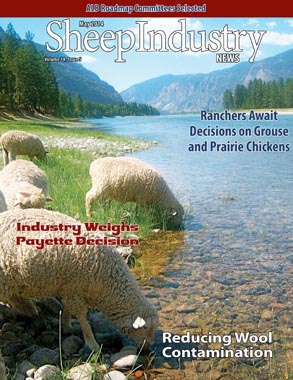
- May 2014
- President’s Notes
- Market Report
- Industry Weighs Payette Decision
- Producers Now Eligible for USDA Disaster Assistance
- ESA listing of Sage Grouse
- Parentage Test Could Benefit Sheep Producers
- Sheep Begin Fire Break Duties
- Don’t Let Your Farm be Fodder for Activists
- Reducing Contamination Vital to Wool Quality
- Data-Driven Approach
- ASI Awarded MAP, FMD Funding
- Obituaries
- Business Spotlight
- ASI News Briefs
- ALB Roadmap Committees Selected
Industry Weighs Payette Decision
An ASI-sponsored task force of sheep leaders is considering its options following the recent ruling that backs the Payette National Forest in its plan to reduce grazing allotments.
U.S. Circuit Court of Appeals Judge A. Wallace Tashima on March 25 denied a motion by the sheep industry to overturn the original Forest Service plan to reduce domestic sheep grazing in the Payette by 70 percent.
Concerns for producers who currently graze sheep on Payette land – along with concerns about the potential of future reductions on other Forest Service lands – led ASI to coordinate discussions on framework put forth by the Forest Service during an April 15 presentation. During that meeting, Region 4 of the Forest Service explained its plans and timelines for the Payette to ASI, the Farm Bureau and state wool grower associations.
On April 17, ASI took part in a conference call between state associations and leaders of ASI’s Resource Council and its Producer Education and Research Council. Information was shared on litigation and legislation, as well as on reports from conversations that sheep ranchers had directly with Forest Service officials about future grazing allotments.
The Forest Service has indicated that reducing disease risks for bighorn sheep is the top reason for cutting back domestic grazing allotments.
“It is apparent to industry leaders that the Forest Service’s Region 4 has been working on plans for adjusting grazing for wild sheep for some time, and it appears to be fast-tracking the analysis and decisions,” ASI Executive Director Peter Orwick said. “It’s important that the sheep industry remind the Forest Service that the National Environmental Policy Act requires consultation between agencies. In this case, the Forest Service should have the opinion of Agriculture Research Service scientists who are conducting disease research on sheep and wild sheep.”
An appeal by the sheep industry is possible. Orwick noted that attorney Bill Myers of Holland and Hart will provide the sheep industry a written summary of the option to appeal the judge’s decision.
Producers, especially those affected by the judge’s decision, are not conceding, instead they are joining with others to decide if an appeal is warranted. Idaho Wool Growers Association (IWGA) President Harry Soulen told the Associated Press that when it comes to weighing an appeal “we’ve got to study this before we make that decision.”
In his ruling, Tashima agreed that the Forest Service had “followed the preponderance of evidence that domestic sheep carry diseases to the wild sheep population.”
That decision differed from the beliefs of ASI, IWGA, the Public Lands Council, the Wyoming Wool Growers Association and the Colorado Wool Growers Association, which in 2012 banded together to file a lawsuit, claiming the Forest Service failed to consider whether disease is transmitted between bighorn and domestic sheep. The suit also questioned whether or not the Forest Service had considered ways to increase bighorn sheep immunity to domestic diseases – or if the federal agency had studied the effect reintroduced wolves have on populations of bighorn sheep.
Tashima rejected those specific arguments, writing that “NEPA does not require that agencies eliminate all risks contributing to a problem before they can address one of those risks.” He noted that the Forest Service concluded that wolves “did not significantly affect the risk of disease transmission to bighorn sheep based on the facts that bighorn sheep and wolves had cohabited in the Payette for many years and that bighorn sheep had ‘survived in large quantities;’ bighorn sheep are generally located in ‘terrain too severe for wolves;’ and no research has shown that wolves affect bighorn susceptibility to disease.”
In response to the sheep industry’s argument that bighorns could contract disease from sheep off of Payette territory, Tashima wrote that the Forest Service “cannot control that risk factor. “
Tashima’s decision was “rather shortsighted,” Soulen, owner of Soulen Livestock, said. “To say that domestic sheep are causing the problem, that’s running loose with your judgment of what you say science is.”
Orwick said that an appeal must be filed with the court within 60 days of the decision, meaning the sheep industry must make its decision by mid-May.
“ASI has been seeking opinions, and the task force spent a lot of time on the litigation. Meanwhile, state executives were seeking input from their members. We plan to keep working on the issue until a decision on the appeal is reached.”

